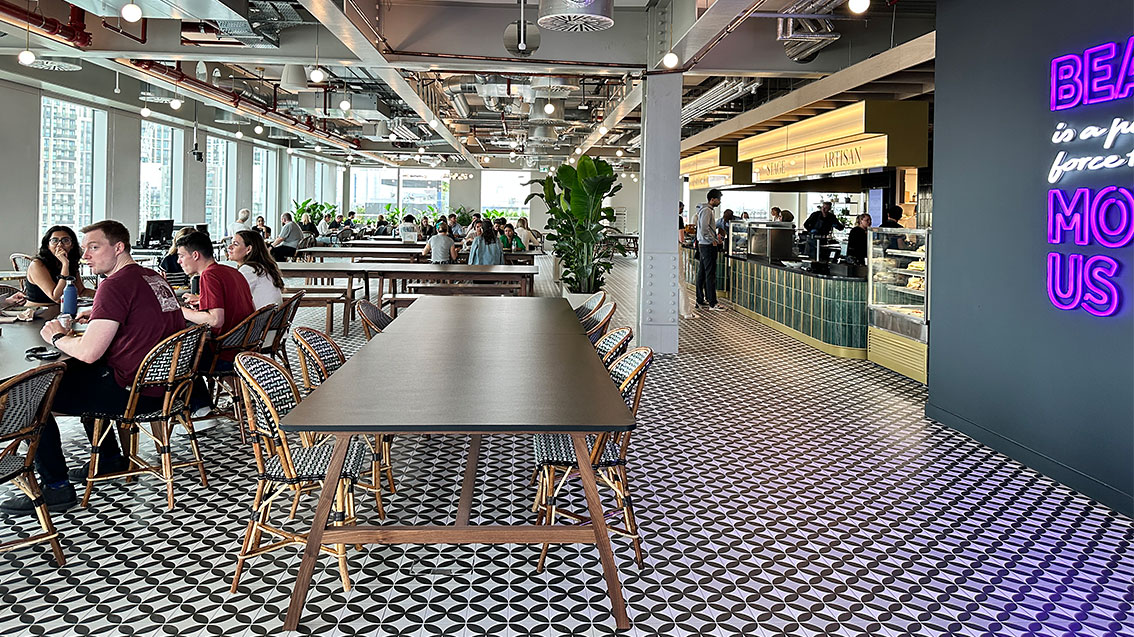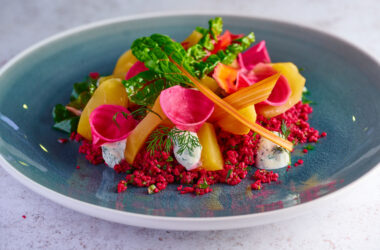Expert Guides
10 tips for a successful catering refurbishment

10 tips for a successful catering refurbishment or new build
Planning a refurbishment project for your current catering space or a brand-new restaurant? Read our top tips to ensure you get the best return on your investment.
Set clear objectives
The main goal of a organisation’s catering is to support its employee’s to do their jobs. Beyond this, there are other objectives too. Teams and visitors want to feel welcome and connected through shared experiences, in settings that offer a variety of conveniences and amenities. The importance of the workplace feeling like a destination should not be underestimated.
Depending on the location of the catering, it could be;
-
A reception cafe that sends a powerful welcome statement to visitors
-
A casual coffee bar alongside an IT help desk
-
A social hub for collaboration or shared experiences
-
Impressive client dining that helps to cement deals and relationships
Whatever the objectives, it is vital to agree a clear brief between the client and caterer. Designs must be future-proofed to ensure that space is optimised now and in the future. And all client’s environmental and social obligations should be met.
Dedicated project manager
It pays dividends to work with experts when undertaking a refurbishment or new catering fit-out project. We always appoint an experienced and dedicated project manager from our senior team. The project manager leads the catering refurbishment or build project. The role includes weekly updates with the client and project team. The tasks include managing the online project plan, budgets and risk register. We always receive great post-project feedback from clients about our project manager and the support they provide for the duration of the refurbishment or build.
Engage stakeholders
To meet the changing needs of both the business and employees it is important to engage with users and understand what they expect from their catering. During the planning stage we always propose a survey. We ask customers what they like and dislike and uncover their ambitions for the new catering spaces. We do this for both staff dining and hospitality. Tailored focus groups with Executive PAs and super-users also provide valuable insights into hospitality and fine dining requirements.
We always suggest a collaboration meeting with our client’s other FM service providers. Meeting the cleaning, waste, reception or concierge suppliers is essential during stakeholder engagement. This collaborative approach ensures a seamless FM services provision.
Optimise the space
We understand clients’ expectations for buildings that provide inspiring and intuitive workplaces. Good buildings enhance employee wellness, and catering can act as the hub for this. Clients increasingly want more experiential catering with informal meeting spaces. With the war for talent intensifying, companies now view their workplace as a differentiation tool. This assists them to attract and keep great people, as well as enables employees to work and collaborate successfully.
Flexibility designed-in
As part of the planning and design process it is important to create a service that caters for hybrid working. Creating a space that is multi-functional and can transform into another genre of catering is what our clients expect from a design. A catering facility that can offer a vibrant barista style coffee service by day and then effortlessly turn into contemporary evening bar maximises clients budgets and provides a greater ROI. It also delivers an aspirational office and provides added value from catering.
Consult design experts
At BM caterers we work with specialist catering design firms. After we have defined the business and customers’ needs, we engage with our interior and kitchen suppliers to design the space. We also work closely with BM’s subject matter experts. These include Pete Redman, Chef Director and Adrian Steenkamp, Coffee Brand Manager. Led by our clients we may also re-engage with our client and customer stakeholders during the process to ensure our designs meet their objectives and needs.
Take a holistic approach
Many components create amazing catering facilities. Everyone needs to share the client’s vision. Whether it’s a refurbishment or new build, a diverse range of partners will create everything from CADs to mood boards. From experience we know it is important to invest the time to create one vision document to share with all partners. This sets out our client’s aspirations. It includes the customer journey, experience, food, and beverage offer, alongside the architectural and design elements. It’s the most successful way to gain buy in and deliver a cohesive and on-point catering service.
Meet social and environmental obligations
Responsible businesses want to achieve net-zero carbon emissions by 2030. Sustainable restaurant design in the workplace underpins this. Clients want spaces that conserve resources and avoid waste. Employees expect their employers to be responsible and Gen Z are more attracted to ethical workplaces.
As a leader in sustainable food, we create sustainable catering facilities that also deliver an amazing experience. When designing a new catering facility, we ask what impact the operation will have on the environment? This includes everything from building materials to energy usage, pollution prevention to waste reduction and recycling. A new catering facility is an opportunity to create a lower-carbon footprint, and higher energy efficiency.
We always aim to dispose of excess pre-loved equipment in a responsible way. Our options include repurposing, selling the equipment and donating it to a charity. Closed loop recycling allows equipment and furniture to be repurposed or re-manufactured.
Effective communications
Even though many aspects of a refurbishment or build project are managed by a small team, we don’t forget the ultimate stakeholder – the end user. Through the duration of the planning and build process we organise many workshops with different audiences. This includes equipment showcases, food presentations and food and coffee tastings.
Once the countdown to a grand opening begins, tempting our customers’ taste buds is a pre-requisite for success. We create messaging that builds excitement and as launch day gets nearer, they evolve into practical and factual communications. For example, where there’s a facility refurbishment, we use the construction hoarding to publicise the offer and launch. It’s a bold and visual way to shout about the food service to come. Digital and video teaser campaigns promote the food and beverage offer and present discount codes to encourage participation from the outset.
Pop-ups to allow our customers to have ‘a taste of what’s to come’ is a great opportunity to secure loyalty in advance. A counter ‘takeover’ in an existing restaurant or a food truck outside on induction day – anything is possible. These live experiences are always explored as they add huge employee value as well as encourage future customer commitment.
Plan and test!
As the opening approaches the project manager’s robust mobilisation plan is actioned. This project time-line captures every task. Included is a handover from the contractors, team training, receipt of catering goods and equipment testing. A soft launch for the facilities plays a vital part in the successful launch. The ideal period for the team to settle into their new environment is two weeks.
As employees’ expectations change, businesses will need to work hard to create inspiring, sustainable, and efficient workplaces that invite people in and inspire them to connect, socialise, and collaborate.
If you would like more information on how BM caterers can help you with a successful catering refurbishment or new build, please contact [email protected]





